
Black Vine Weevil – Otiorhynchus sulcatus
Black Vine Weevil (Otiorhynchus sulcatus)
Common Name: Black Vine Weevil
Latin Name: Otiorhynchus sulcatus
Appearance:
Adults:
Adults are a dark black, matte color with fused wing coverings, making them unable to fly. They have six legs and two long antennae on the top of their heads. Because they are nocturnal, they emerge at night to feed on the outer sections of leaves. They have long, snout-like heads.
Larvae:
Small, slightly curled, creamy-white larvae with light brown heads measuring 10mm in length. They are found around the roots.
Eggs: The eggs are so little that you have to use a hand lens to view them.
Territory:
The black vine weevil beetle arrived in the United States in the 1800s and has become a major problem. Among the plants that black vine weevils consume are Azalea, euonymus, hemlock, hosta, rhododendron, and yew.
Damages caused by Black Vine Weevil:
The larvae feed on the roots, which causes the most harm. After destroying the roots, the larvae proceed into plant corms, rhizomes, and stem bases. Larvae can also feed above ground within plant stems. Adult beetles and larvae are both polyphagous, feeding on various plant species. Under field circumstances, large concentrations of larvae can damage plants. Established crops tolerate harm better than young plants or newly planted cuttings. Adult beetles are only active at night, taking circular nibbles from the edges of the leaves. This damage is rarely an issue in vegetable and fruit crops, but it lowers the value of decorative plants.
Life history and habits:
This pest overwinters in the soil as immature larvae. In early spring, mature larvae are 10-15 mm long and establish resting (pupal) cells in the soil. Adults typically emerge from late May to June, and only females have been observed in North America. They are energetic nocturnal feeders that descend to the ground swiftly when disturbed. During the day, adults hide in dark areas on the stems of plants with dense foliage and in leaf litter and mulch. Adults need 21-28 days of leaf-eating before they can lay eggs. They may lay up to 500 eggs during a 14-21 day span. Eggs are placed towards the base of host plants in the soil. They hatch into little larvae in 10-14 days and feed on roots until temperatures drop in the fall, causing them to travel deeper into the soil to overwinter. Adults may occasionally survive the winter within their houses. In Pennsylvania, just one generation happens each year.
